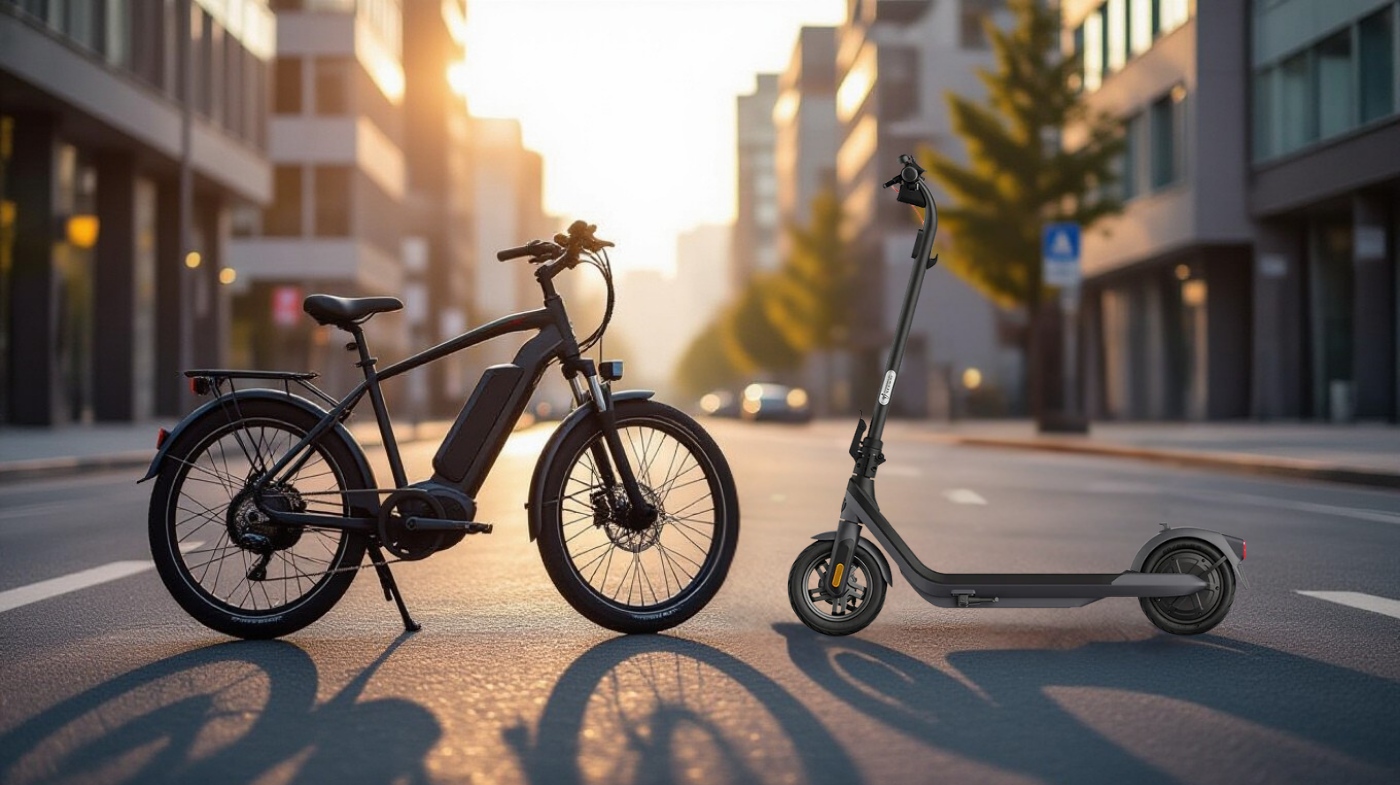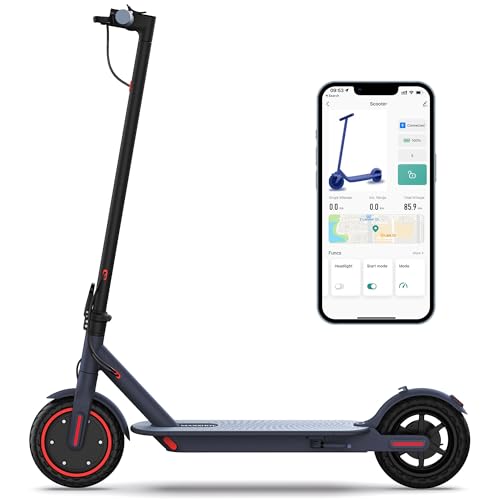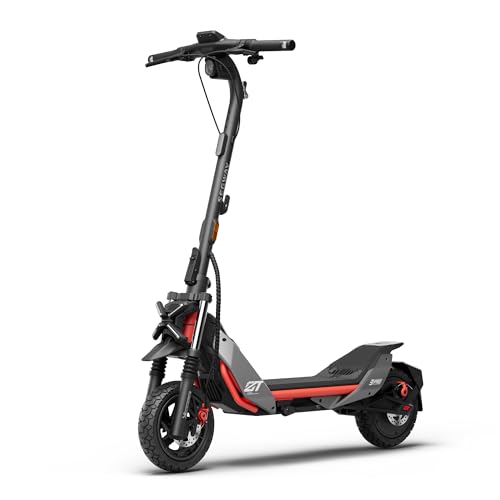When choosing between an electric bike and a scooter, consider that e-bikes offer faster acceleration and longer range due to pedal-assist motors and larger batteries. Scooters, though, excel in portability and lower maintenance costs with instant throttle control.
E-bikes handle varied terrain better and provide a comfortable seated ride, while scooters are lighter, fold faster, and suit short urban trips. You’ll find more insights on speed, battery life, and cost differences as you explore further details.
No products found.
- Great Performance on Your Way: Equipped with 350W powerful motor and high capacity battery, V1…
- Keep You Safe: Tested by UL2272, It’s more safe and professional. Bright headlight make you visible…
- Lightweight & Portable Folding: Only weigh 31 pounds, this electric scooter can be folded within 3…
Key Takeaways
- E-bikes provide pedal-assist and smoother rides with larger wheels, while scooters rely on throttle and excel on flat urban surfaces.
- Scooters are lighter and fold more compactly, making them easier to carry and store than heavier, bulkier e-bikes.
- E-bikes typically have longer range and battery life, often exceeding 100 miles, compared to scooters’ 10-50 mile range.
- Maintenance costs are lower for scooters due to fewer moving parts, but e-bikes offer more comfort and stability.
- Legal speed limits vary: e-bikes can reach up to 28 mph, while scooters are commonly capped at 20 mph.
Comparing E-Bikes and Scooters: Key Differences at a Glance
| Feature | Electric Bike | Electric Scooter |
|---|---|---|
| Speed | Up to 28 mph (with pedal assist) | 15–25 mph, some models exceed 45 mph |
| Range | 40–100+ miles | 10–50 miles, depending on model |
| Ride Comfort | Seated position, larger wheels, better suspension | Standing ride, smaller wheels, more vibration |
| Portability | Heavier (35–70 lbs), bulkier folding | Lighter (20–45 lbs), folds compactly and quickly |
| Terrain Handling | Better for hills and rough surfaces | Best on flat urban terrain |
| Battery Life | 500–1000 charge cycles, longer service life | 300–600 charge cycles, shorter lifespan |
| Maintenance | Higher, more moving parts | Lower, fewer components |
| Legal Speed Limits | Up to 28 mph, depending on class | Typically capped at 20 mph, more local restrictions |
Speed and Performance Comparison
Although both electric bikes and scooters serve urban commuters well, their speed and performance differ distinctly due to design and regulatory factors. E-bikes typically max out at 20 to 28 mph, limited by regulations, while scooters usually range from 15 to 25 mph. Riders should always obey traffic laws to ensure safe operation in urban environments.
High-performance scooters can surpass 45 mph, outpacing most e-bikes except rare specialty models. You’ll notice e-bikes use pedal-assist motors, blending your pedaling power with motor support for smooth acceleration and better hill climbing.
Scooters rely solely on throttle control, delivering instant power and nimble acceleration thanks to lighter weight. Terrain adaptability also favors e-bikes with larger tires and suspension, ensuring stable rides on rougher surfaces, whereas scooters excel on flat urban pavement. Additionally, electric scooters often come equipped with advanced features such as LED lights and digital displays, enhancing convenience and safety.
Range and Battery Life Differences
When comparing electric bikes and scooters, their range and battery life reveal significant differences rooted in battery capacity, efficiency, and design. E-bikes typically achieve about 2 miles per amp hour (Ah), double the range efficiency of e-scooters, which average 1 mile per Ah. This difference is largely due to e-bikes’ lower rolling resistance and more efficient energy use compared to scooters.
For instance, a Panasonic e-bike with a 25-30 Ah battery can exceed 100 miles, while a similarly rated e-scooter might only reach 10-12 miles. Pedal-assist on e-bikes further extends range by reducing motor load. Battery capacity typically declines to 70–80% after maximum charge cycles, which impacts the effective range over time.
E-scooters usually have smaller batteries (7-20 Ah), limiting their range to 11-50 miles depending on power and terrain. Battery longevity also differs; e-bike batteries last 500-1000 cycles, outlasting e-scooters’ 300-600 cycles.
Despite higher replacement costs, e-bike batteries’ larger capacity and quality yield longer service life and superior range. Proper battery maintenance can help maximize lifespan and performance for both vehicle types.
Portability and Convenience Factors
While both electric bikes and scooters offer electric mobility, their portability and convenience differ markedly due to weight, foldability, and carrying ease.
Electric scooters weigh between 20-45 lbs, significantly lighter than folding e-bikes at 35-70 lbs, making scooters easier to carry, especially upstairs or on public transit. Their lighter weight also contributes to better acceleration and top speed performance in urban settings.
Scooters fold quickly via simple mechanisms into compact, slender shapes that fit under desks or in car trunks. In contrast, e-bikes require 15-30 seconds to fold and produce bulkier packages demanding more storage space.
Scooters often include carry handles or straps, enhancing transportability and supporting multimodal commuting. Their compact, lightweight design makes them particularly suitable for urban environments.
In contrast, e-bikes, despite improved folding designs, remain less convenient to carry, favoring longer rides over portability. Therefore, scooters excel in frequent, short urban trips needing rapid folding and compact storage.
Comfort and Legal Considerations
Although electric bikes and scooters both serve as popular urban mobility options, they differ markedly in comfort and legal frameworks. You’ll find electric bikes offer superior comfort with seated riding positions, larger wheels, and suspension systems that absorb road shocks. Their secure locking options also provide enhanced safety during transport.
Scooters, typically designed for standing, can cause discomfort on longer rides despite some having pneumatic tires and suspension. Their smaller wheels and lack of suspension often result in more vibrations being transferred to the rider. Legally, scooters are often capped at 20 mph with stricter local regulations, while e-bikes allow speeds up to 28 mph depending on class and jurisdiction.
E-bikes benefit from pedal assist, affecting their legal status closer to traditional bicycles. Helmet and age requirements vary, but scooters usually face more restrictions on where you can ride.
Stability also favors e-bikes due to larger wheels and sturdier frames, enhancing safety compared to scooters’ smaller platforms and higher fall risk. Additionally, e-bikes often feature disc brakes which provide more effective stopping power and contribute to rider safety.
Frequently Asked Questions
How Do Electric Bikes and Scooters Impact the Environment Differently?
You’ll notice electric bikes generally have higher manufacturing emissions due to larger lithium-ion batteries and heavier frames. However, they offset this by replacing more car trips, cutting overall emissions.
Scooters use smaller batteries, so their initial footprint’s lighter. Yet, their shorter lifespan and frequent replacements can increase total impact.
Both emit minimal operational CO2 and benefit from recycling programs, but e-bikes usually achieve greater net environmental benefits over their lifecycle.
Can Electric Scooters and Bikes Be Charged Using Solar Power?
You can charge both electric scooters and bikes using solar power if you use suitable solar panels and chargers matching their battery voltages, typically 36V to 60V.
Scooters usually have smaller batteries (200-800 Wh), so a 100W-200W portable panel can charge them in a few hours.
Bikes often need more energy due to larger batteries, requiring higher capacity panels or longer sunlight exposure for efficient charging.
Are There Specific Safety Accessories Recommended for Each Vehicle Type?
You should choose safety accessories tailored to your vehicle. Helmets are essential for both, but bike helmets often offer better ventilation, while scooter helmets might be more compact.
Eye protection, gloves, and reflective gear improve visibility and grip for both. Electric bikes benefit from bike lights, locks, and padded cycling shorts, whereas scooter riders need weather-resistant clothing, wrist guards, and sturdy shoes for stability.
Both require knee and elbow pads for impact protection.
How Do Weather Conditions Affect Electric Bike and Scooter Performance?
You’ll notice weather impacts traction and battery life markedly. Rain and ice reduce grip, but smaller scooter tires slip more easily than larger bike tires, which offer better stability.
Cold temperatures sap battery efficiency, with scooters’ smaller batteries losing range faster. Wind drains scooter range sharply due to less rider power assistance.
Mechanical wear accelerates in wet conditions; bikes have sturdier frames and better weatherproofing, so they handle rough terrain and moisture better than scooters.
Choose Smart: E-Bike or Scooter for Your Daily Journey
Choosing between an electric bike and scooter is like picking a tool from a well-stocked toolbox—each excels in specific tasks. If you value speed, range, and comfort for longer commutes, the e-bike’s 40-60 mile range and ergonomic design serve you better.
For quick, portable trips, the scooter’s compactness and lower maintenance shine. Understanding these nuances guarantees you select the most suitable ride tailored to your daily demands and lifestyle.
No products found.
- Extended Battery Life: Travel up to 43.5 miles on a single charge in ECO mode, ensuring long,…
- Effortless Control: Easy-to-use controls and intuitive handling make the scooter simple to operate,…
- Built for Durability: Constructed with high-quality materials designed to endure rough use and harsh…
Last update on 2026-01-06 / Affiliate links / Images from Amazon Product Advertising API



